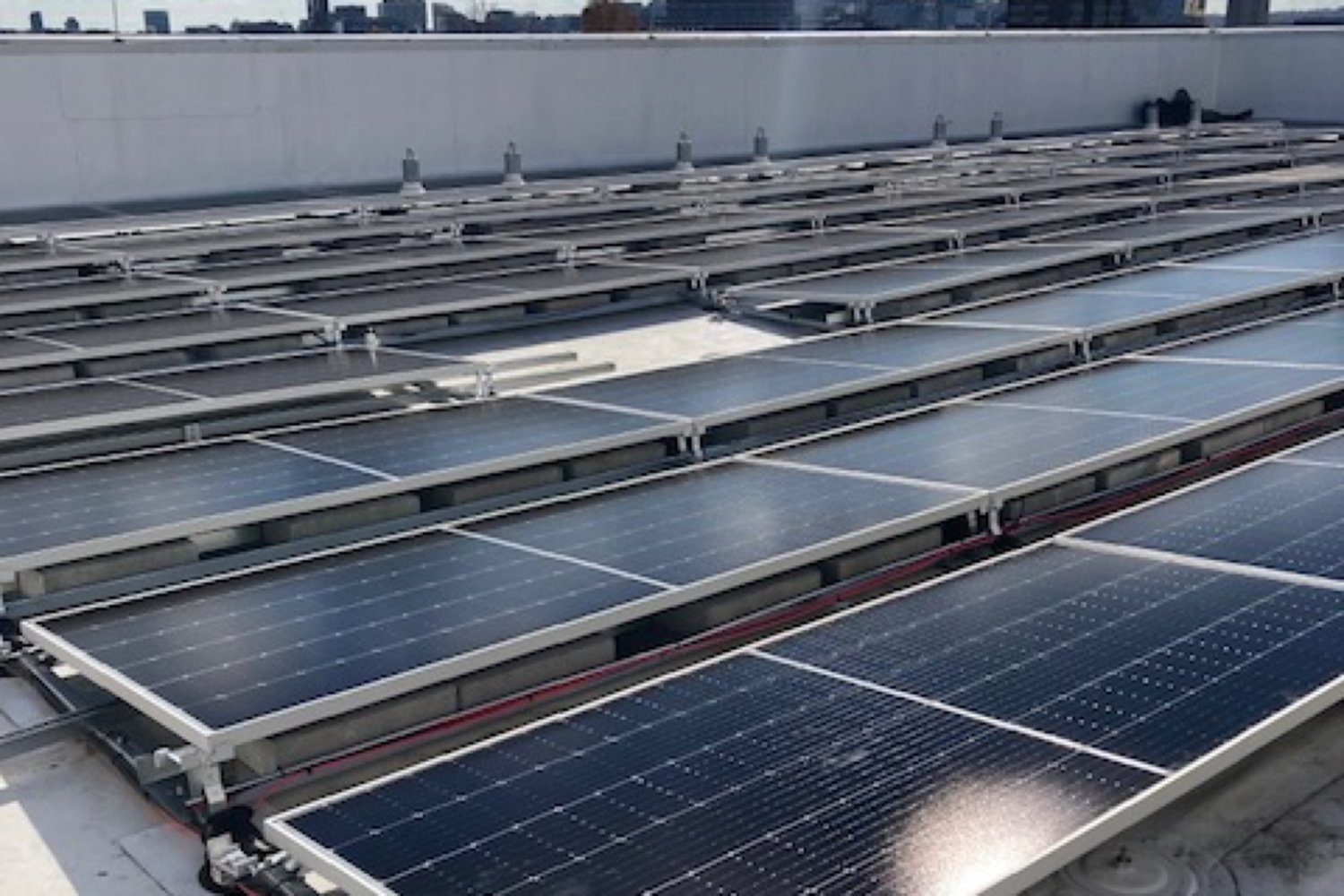New solar projects will grow renewable energy generation for four major campus buildings
November 25, 2024

In the latest step to implement commitments made in MIT’s Fast Forward climate action plan, staff from the Department of Facilities; Office of Sustainability; and Environment, Health and Safety Office are advancing new solar panel installations this fall and winter on four major campus buildings: The Stratton Student Center (W20), the Dewey Library building (E53), and two newer buildings, New Vassar (W46) and the Theater Arts building (W97).
These four new installations, in addition to existing rooftop solar installations on campus, are “just one part of our broader strategy to reduce MIT’s carbon footprint and transition to clean energy,” says Joe Higgins, vice president for campus services and stewardship.
The installations will not only meet but exceed the target set for total solar energy production on campus in the Fast Forward climate action plan that was issued in 2021. With an initial target of 500 kilowatts of installed solar capacity on campus, the new installations, along with those already in place, will bring the total output to roughly 650 kW, exceeding the goal. The solar installations are an important facet of MIT’s approach to eliminating all direct campus emissions by 2050.
The process of advancing to the stage of placing solar panels on campus rooftops is much more complex than just getting them installed on an ordinary house. The process began with a detailed assessment of the potential for reducing the campus greenhouse gas footprint. A first cut eliminated rooftops that were too shaded by trees or other buildings. Then, the schedule for regular replacement of roofs had to be taken into account — it’s better to put new solar panels on top of a roof that will not need replacement in a few years. Other roofs, especially lab buildings, simply had too much existing equipment on them to allow a large area of space for solar panels.
Randa Ghattas, senior sustainability project manager, and Taya Dixon, assistant director for capital budgets and contracts within the Department of Facilities, spearheaded the project. Their initial assessment showed that there were many buildings identified with significant solar potential, and it took the impetus of the Fast Forward plan to kick things into action.
Even after winnowing down the list of campus buildings based on shading and the life cycle of roof replacements, there were still many other factors to consider. Some buildings that had ample roof space were of older construction that couldn’t bear the loads of a full solar installation without significant reconstruction. “That actually has proved trickier than we thought,” Ghattas says. For example, one building that seemed a good candidate, and already had some solar panels on it, proved unable to sustain the greater weight and wind loads of a full solar installation. Structural capacity, she says, turned out to be “probably the most important” factor in this case.
The roofs on the Student Center and on the Dewey Library building were replaced in the last few years with the intention of the later addition of solar panels. And the two newer buildings were designed from the beginning with solar in mind, even though the solar panels were not part of the initial construction. “The designs were built into them to accommodate solar,” Dixon says, “so those were easy options for us because we knew the buildings were solar-ready and could support solar being integrated into their systems, both the electrical system and the structural system of the roof.”
But there were also other considerations. The Student Center is considered a historically significant building, so the installation had to be designed so that it was invisible from street level, even including a safety railing that had to be built around the solar array. But that was not a problem. “It was fine for this building,” Ghattas says, because it turned out that the geometry of the building and the roofs hid the safety railing from view below.
Each installation will connect directly to the building’s electrical system, and thus into the campus grid. The power they produce will be used in the buildings they are on, though none will be sufficient to fully power its building. Overall, the new installations, in addition to the existing ones on the MIT Sloan School of Management building (E62) and the Alumni Pool (57) and the planned array on the new Graduate Junction dorm (W87-W88), will be enough to power 5 to 10 percent of the buildings’ electric needs, and offset about 190 metric tons of carbon dioxide emissions each year, Ghattas says. This is equivalent to the electricity use of 35 homes annually.
Each building installation is expected to take just a couple of weeks. “We’re hopeful that we’re going to have everything installed and operational by the end of this calendar year,” she says.
Other buildings could be added in coming years, as their roof replacement cycles come around. With the lessons learned along the way in getting to this point, Ghattas says, “now that we have a system in place, hopefully it’s going to be much easier in the future.”
Higgins adds that “in parallel with the solar projects, we’re working on expanding electric vehicle charging stations and the electric vehicle fleet and reducing energy consumption in campus buildings.”
Besides the on-campus improvements, he says, “MIT is focused on both the local and the global.” In addition to solar installations on campus buildings, which can only mitigate a small portion of campus emissions, “large-scale aggregation partnerships are key to moving the actual market landscape for adding cleaner energy generation to power grids,” which must ultimately lead to zero emissions, he says. “We are spurring the development of new utility-grade renewable energy facilities in regions with high carbon-intensive electrical grids. These projects have an immediate and significant impact in the urgently needed decarbonization of regional power grids.”
Higgins says that other technologies, strategies, and practices are being evaluated for heating, cooling, and power for the campus, “with zero carbon emissions by 2050, utilizing cleaner energy sources.” He adds that these campus initiatives “are part of MIT’s larger Climate Project, aiming to drive progress both on campus and beyond, advancing broader partnerships, new market models, and informing approaches to climate policy.”
Search
RECENT PRESS RELEASES
Related Post


